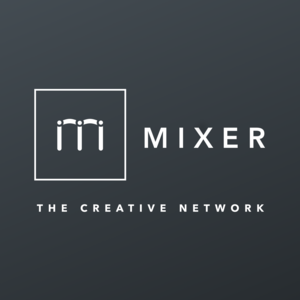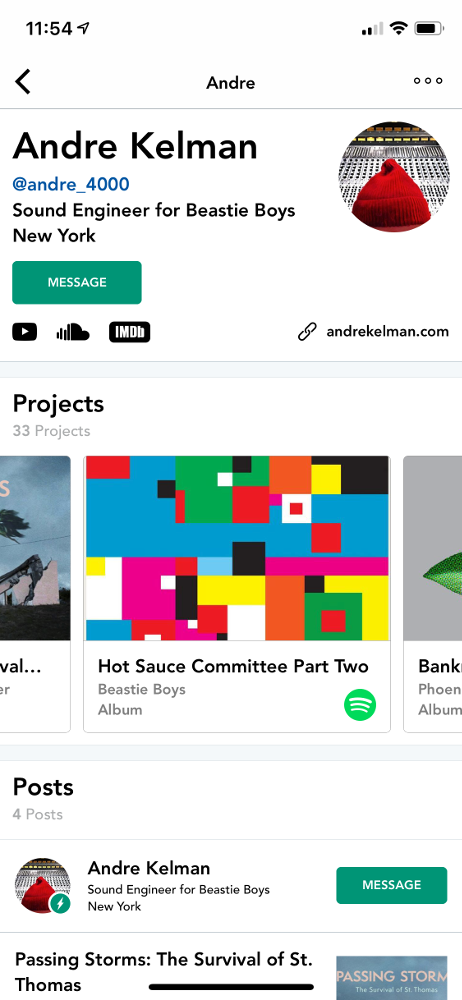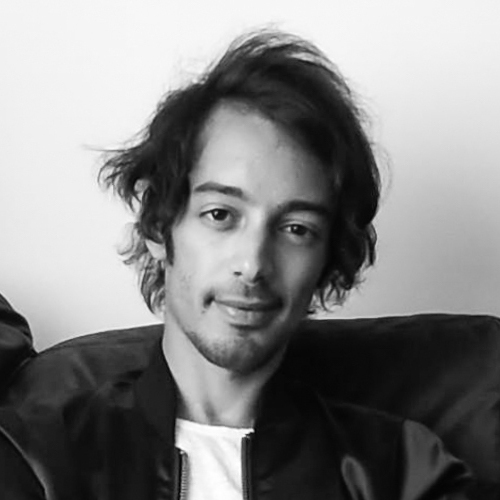An App for Creative Careers: Audio Pros Make Moves with Mixer
Got talent? As everyone in audio knows, being an ace often only gets you so far.
Creative professionals have to be better than ever at networking, and not just with people in their same vertical. Music artists, mixers, producers and mastering engineers need a way to step outside their circle, so they can bridge the gap between themselves and birds of a different feather.
There’s an app for that: Mixer. Seeing a gap in what wide-ranging resources like LinkedIn can do, this networking tool consciously set out to connect people in the art, music, fashion, and film industries, providing them with opportunities to form complementary collaborations. There is a vetting process for all members who, once accepted, can easily link their social and SoundCloud feeds to highlight recent projects. Once a user is onboard, Mixer costs $9.99 per month, or $65.99 for the year.
From there, Mixer can be an effective platform for forging fresh relationships. An EDM artist, DJ or singer/songwriter, for example, can easily branch out to find a new musical collaborator, producer, or mixer; a photographer for their album artwork; an animator, and/or videographer for their video. Or a filmmaker, composer and music supervisor who otherwise may never have met can link up and score a soundtrack out of left field.
Like any networking systems, users get out what they put in to Mixer. Adding a new accomplishment to your feed on a regular basis will definitely increase the number of invitations to connect and spark authentic conversations. And Mixer isn’t just for beginners or wannabes either – look around, and some highly accomplished members will surface.
The interface is intuitive, but building up this ambitious app so it would function smoothly was no snap. In this interview, Mixer co-founder and CEO Anis Bennaceur talked to SonicScoop about the evolution of their app, the highs and lows of taking it live, and the growing importance of targeted connectivity in a fast-changing media industry.
How would you characterize the current creative/financial ecosystem for people in creative professions today – especially audio and visual fields?
I love this question, we’re diving in straight away! In the music world, while physical sales are at a fifth of what they were 20 years ago, streaming is at an all-time high, with subscription services such as Apple Music and Spotify driving double-digit growth in sales – streaming revenue growth for last year was over +40%.
As for the film industry, while in five years physical sales will be half of what they are today, Internet VOD services led by Netflix, Amazon Prime Video, and Hulu, are projected to double in the next five years.
You see, tech companies are now leading the creative ecosystem, and we’re walking on shifting sands right now. These tech companies are offering increasing possibilities for artists to promote themselves, distribute their work independently, and create more and shorter content.
Now, there are still massive inequalities in wealth distribution in the creative industries. Musicians are only making a tenth of the music industry’s revenue. And then the top 1% of the artists account for more than 80% of the streaming revenue. We need to find new ways to connect emerging artists with top producers and songwriters. We need to find new ways to connect this industry better so that the most talented yet underrated artists of today get connected to the right industry leaders.
And it’s not necessarily just connecting the people who already are pursuing these careers, it’s also about finding the talented people out there just getting started where one peer, one connection early on can accelerate their career.
What are the specific opportunities that producers/engineers/mixers/mastering engineers have right now? And on the flipside, what are the major challenges that you think they face?
It’s all about access. That’s the opportunity and challenge. Anyone now, with the right software, toolkits, and courses has the potential to work like professionals. And both up-and-comers and professionals now have access to more artists than ever. However, it becomes increasingly harder to filter through the noise and pick the right person to work with.
From Idea to Actual App
When did Mixer launch, and who is the team behind it?
We softly launched Mixer in summer 2015, but our platform has kept evolving ever since – it’s so much different now from whatever we had then!
We’re three co-founders: Cody Simons, a Harvard alumnus who worked on different projects before. Alex Carapetis, who’s an incredibly talented musician who currently drums with the Voidz, and has toured with Nine Inch Nails, Phoenix and Wolfmother. And then me – I was working in the growth team of another consumer startup that has now become a publicly traded company.
That’s a solid core. What was your inspiration behind Mixer — what made you feel that it was necessary?
There was no serious platform for professional creatives at the time. Social networks that are at scale, like Instagram for example, are an incredible tool for distribution, but not to properly showcase your work or research other people by professions in your city.
How do people join Mixer? How are memberships structured?
People can be referred by their friends, or download our app on the AppStore here. Once they finish their application, their profile is reviewed by our team before being approved.
Once you’re in, you can start building your industry connections, share your work, and apply to job listings on the platform.
We have also launched a Web section for companies and brands that want to directly hire from this pool of talent.
From there, what do you think makes the Mixer app uniquely qualified to accomplish its mission?
Because our talent pool is vetted, you know that you’ll connect with industry professionals with actual credits. We have also connected our platform with the APIs of some of the leading broadcasting apps, so in the music industry, Spotify, Soundcloud, and soon Apple Music.
Then, as you go through our user base, you’ll be able to filter specifically by industry and profession. So if you need a sound mixer based out of Los Angeles, you’ll be able to go through them, see their credits, connect with them, and start a conversation.
We also have a marketplace where our members can apply to different job listings, and can be reviewed based on their credits or portfolio of work. Our end goal is to connect an industry better and therefore provide more liquidity and transparency in a world that really needs both of those.
Integrating the User Base
Focusing on your users, who have you found is gravitating to Mixer so far?
There’s a split between film, music, arts and fashion, and we have around 20,000 vetted members now. We do see a higher usage throughout musicians, photographers, cinematographers, and stylists. We’re mostly concentrated in Los Angeles and New York for the moment.
What are some of the success stories that you’ve heard from Mixer users, especially on the audio side?
We have so many of those. Not only within the same industry, but also cross-industry. A couple of weeks ago, I ran into Albert Hammond Jr. – guitarist from the Strokes and solo artist – that told me that he had connected on Mixer with Nicole Row, who plays bass for Panic! At The Disco and for Miley Cyrus – and that they played music together. Musician Z-Berg from the band Phases found her collaborator and make-up artist for her most recent music video through Mixer. Andre Kelman, sound mixer who has worked with the Beastie Boys and Phoenix among many other artists, was hired for a variety of projects through Mixer.
On a connectivity level, Alex Kapranos – lead singer of Franz Ferdinand – once told me he was quite pleased to have re-connected through Mixer with all these great musicians that he had met in the past.
What are your tips for Mixer users who want to make the most of the app?
At the end of the day, it all comes down to how much time and effort you put in it.
If you use it enough to connect with the people that you’re really interested in and message them you’ll definitely get a lot of work, and actual great work.
Making the Most of Mixer
What have you learned about app creation/design from making Mixer? Tell us about the surprises — both rewarding and challenging — about being in the app business.
Creating a network is always difficult as you get started. People have a very high standard from the products they already currently use – Facebook, Instagram, Twitter, etc. While it’s gotten easier to get off the ground, you’re never going to have the same smooth experience and full feature set as these companies who employ thousands of more developers than your small team.
It’s an interesting game of prioritization – members ask for tons of different improvements and features but you only have so many man hours. It is an incredibly rewarding experience, however, as every connection made and every job filled/worked through the app is made through the hard work of a handful of people.
Every app is just competing to be valuable enough to have a few minutes of people’s time every day, week or month – and you have to fight really hard to be beneficial enough towards a person’s personal or business that makes you worthy of their time.
Thanks for that frank assessment of the landscape. Finally, what do you see next for Mixer — how do you anticipate the app will continue to develop?
We’re constantly looking for new ways to foster connections. We’ll be adding genres and attributes, make the platform more intelligent when it comes to connecting you with the right people based on who you’ve interacted with in the past. We’re also improving the recruiter side, to increasingly attract job posters.
Last but not least, we’re architecting our feed in a way that it becomes more industry news-heavy, pulling some content from media sources and redirecting our users to those media for more. The idea here is to become the first app that creative professionals open to know about what’s around them, who to work with, and get into their daily routines.
— David Weiss
Please note: When you buy products through links on this page, we may earn an affiliate commission.










[…] Creative professionals have to be better than ever at networking, and not just with people in their same vertical. Music artists, mixers, producers and mastering engineers need a way to step outside their circle, Read more… […]